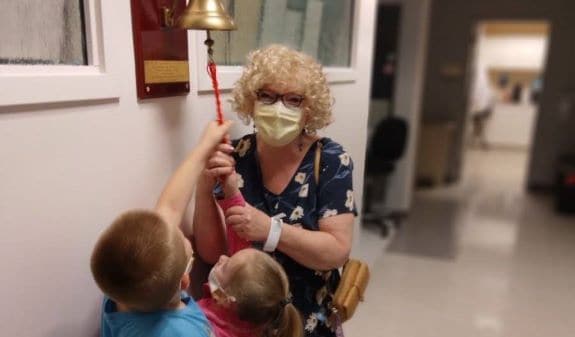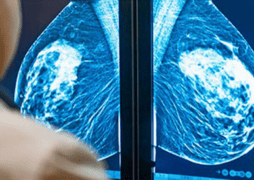It can seem like health writers are obsessed with numbers. Pull up any news article or blog post on breast cancer, and you’ll likely wade into a sea of percentages, decimals, odds and fractions.
Often, these numbers describe “risk.” It’s a familiar term but also one that can have some specific meanings when it comes to cancer. Reviewing some of these meanings can help women better understand breast cancer, its risk factors and their relationship to each. You will also get a chance to test your own breast cancer knowledge along the way.
Note that all of the numbers below refer to risk among women in the U.S.
So what is risk exactly?
At its most basic, risk describes the chance of developing a disease over a certain period of time. Though any timeframe can be used, common periods for breast cancer are lifetime risk, 10-year risk and 20-year risk.
Question#1: Lifetime risk
The lifetime risk of breast cancer in a woman in the U.S. is 1 in 8. This is the same as what percentage? (Check your answer below.)
a. 1%
b. 8%
c. 12%
d. 80%
Lifetime risk describes the chance of developing breast cancer at any point in adulthood, usually up to age 80 or 85. The “1 in 8” lifetime risk refers to an average woman’s risk of developing breast cancer at some point in her lifetime if she lives to be 80 or 85. One in 8 is the same as a 12 percent lifetime risk of developing breast cancer (that is 1 divided by 8 = 0.12).
Though lifetime risk can be useful for providing a broad view of a disease’s impact in the population, it can also overstate the breast cancer threat because not every women lives to 80 or 85. In addition, the chance of getting breast cancer is not the same throughout a woman’s life, but increase as she gets older.
Looking at shorter timeframes can provide a better sense of a woman’s actual breast cancer risk. This is especially true for younger women.
Question #2: 10-Year Risk
What are the chances a 40 year-old woman will develop breast cancer by the time she turns 50? (Check your answer below.)
a. 80%
b. 20%
c. 3.5%
d. 1.5%
Just as the names imply, a 10-year risk describes the risk of developing breast cancer over the next 10 years. These risks are of often much smaller than the overall lifetime risk of 12 percent.
For the average 40 year-old woman, the risk of developing breast cancer by the time she reaches age 50 is 1.5 percent (less than two percent) – and by the time she reaches age 60 is 3.7 percent.1
In comparison, the average 60 year-old woman has a 3.5 percent chance of developing breast cancer by the time she reaches age 70 – and a 6.9 percent chance by the time she reaches age 80.1
Absolute risks vs. relative risks
Question #3 – Relative risk
Women who drink alcohol (one to two drinks a day) have a relative risk of breast cancer of 1.2 compared to those who don’t drink. This means their risk is increased by what percent? (Check your answer below.)
a. 20%
b. 12%
c. 1.2%
d. 0.2% (less than 1%)
The terms “absolute risk” and “relative risk” often appear in news stories and magazine articles on cancer. Although they sound similar, it is important to understand the difference between the two.
Absolute risk counts how many people in a group develop a certain disease over a certain period of time, similar to the lifetime and 10-year risks we described above.
Relative risk, on the other hand, shows risk compared to (relative to) something else. It is most often used to describe the impact that risk factors (like family history, weight and exercise) have on cancer risk. A relative risk shows how much higher, how much lower, or whether there is no difference in breast cancer risk in women with a certain characteristic compared to the risk in women without it.
For example, a relative risk of breast cancer of 1.2 for drinking alcohol (one to two drinks per day) means that compared to women who do not drink, those who have one to two drinks per day have a 20 percent greater risk of the disease.
For a full picture, though, it is important to look at both the absolute and relative risks.
For example, in women ages 20 to 35, there are about 4,200 breast cancers diagnosed each year. So, a risk factor with a relative risk of 1.2 would lead to 840 extra cases of cancer.
In women ages 55 to 64 however, there are about 59,000 cases of breast cancer diagnosed each year. So, a 20 percent increase would lead to 11,800 extra cases of breast cancer. While the relative risk is the same, in older women it leads to a much higher absolute risk of disease – more than ten times the number of extra cases.
What is my personal risk of breast cancer?
Despite the number of websites that offer breast cancer risk calculators, they cannot tell you whether or not you will get breast cancer. Why? Because science is much better at predicting what is going to happen in a group of women than what is going to happen to an individual woman.
Research is based on probabilities. Studies look at groups of women and use this information to estimate what might happen to a similar group of women in the future. While these predictions can be very accurate when estimating what percentage of women in a group will develop breast cancer, they’re less reliable at determining which specific women in that group will get cancer.
Even with these limits, however, it’s important for women to have an idea of their personal breast cancer risk. Women at very high risk because of family history or BRCA1/2 gene mutations can take important steps to lower their risk of developing breast cancer. And, all women should choose healthy lifestyle behaviors that may lower their risk of breast cancer and other health conditions.
Summary
Understanding some basic concepts about risk can help put breast cancer into perspective for women of all ages. While lifetime risk can provide a good overview, shorter 10-year and 20-year absolute risks can provide women with a more practical understanding of their breast cancer risk in the near future.
Relative risks are useful for looking at the potential impact of individual factors (such as alcohol) on breast cancer. However, the real impact of a relative risk can be very different, depending on the absolute risk. When breast cancer (or another health condition) is rare, a relative risk has little impact on the number of cases, but when it is common, the impact is much greater.
Komen resources
Understanding Risk
http://ww5.komen.org/BreastCancer/UnderstandingRisk.html
Breast Cancer Risk Factors
http://ww5.komen.org/BreastCancer/LowerYourRisk.html
Breast Cancer Risk Factors – Facts for Life
http://ww5.komen.org/uploadedFiles/Content_Binaries/806-372a.pdf
Summaries of Research Findings
http://ww5.komen.org/breastcancer/researchtabletopics.html#riskfactors
References
1. Howlader N, Noone AM, Krapcho M, et al. (editors). SEER Cancer Statistics Review, 1975-2011. National Cancer Institute. Bethesda, MD, http://seer.cancer.gov/csr/1975_2011/, 2014.
Answers
Question #1: c. 12%
Question #2: d. 1.5%
Question #3: a. 20%



